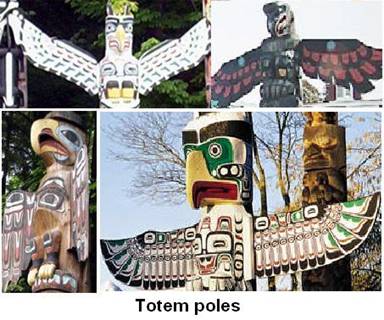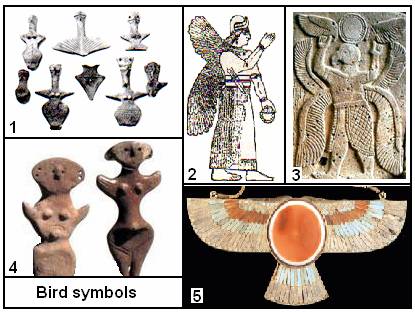|
We saw
in Chapter 26, African
Expansion and in Chapter 27
Olmec, Toltec and Maya,
that the sun-worshipping cultures considered the birds in
general as being special animals because of their capacity to
fly towards the sky, the realm of the sun. Such a capacity was
also accepted to be a feat belonging to the shamans.
Therefore, the bird symbolism has been extensively used in all
shamanic cultures. The original cradle of shamanism has been
Central Asia and has spread to the ancient world from this
region.
Below we see
some totem poles of the North American so called “native
people”. Bird figures standing at the top of the totem poles
represent the spirit of the ancestors as well as the
sun-deity. For the northern tribes of America totem poles were
the symbols of shamanic guardian-spirit experiences. The
shaman or the medicine man would dress up like a bird and
perform ecstatic, spiritual flights towards the sky in order
to communicate with the deities and ancestors (see Chapter 23,
The Issýk Kurgan).
Trudy Griffin-Pierce says
(1):
The figures on the pole were not actually totems because there
was no sense of avoidance of the depicted animals or
prohibitions against killing or eating them. Instead, they
were special helping spirits from the animal world which had
become heraldic crests.

The pictures
below are examples of the birds symbolism found allover the
world.
1. Small
amulets excavated from a kurgan in Central Asia
(2).
These are symbolic figures of female shamans and were carried
on the body or hanged from the neck in order to be protected
from harmful spirits. They also indicate that shamanism was
essentially a female activity.
2.
The winged Sumerian sun-god Utu is clearly depicting the
connection between the bird and the sun. His helmet has ram
horns and he is holding a torque in his left hand. The torque
had a special meaning for ancient sun-worshiping societies.
The word “torque” is believed to have originated from the
Latin word “torquere”, but what was its original form? It is
quite possible that “torque” was originally a solar symbol of
the Etruscans. It suffered the following transformations:Tur-Osc
(Etrusc) => Torosc => Torque. We find here the
connection to the Tur (Toor) and Osc people that came to the
Italian peninsula before the Romans. The torque, which has the
form of a circle also means “the surrounding” or “the circle”
and stands for the land or region under control by the Tur
(see Chapter 8, The
double-edged ax). The torque was either held in the
hand or surrounded the neck of the Och leader and is found in
many different cultures that originated from Asia. More detail
will be given in the following chapters.
3.
A Hittite deity from Karatepe – Anatolia
(3).
The winged deity takes its place among a series of wall relief
at the entrance wall of a late Hittite castle. The
anthropomorphic figure has a bird beak and is holding a winged
solar disk above its head, indicating the clear connection
between the bird and the sun.
4.
Winged female amulets from Ikiztepe – Anatolia. These small
idols are from the Bronze Age that lasted from 3300 BC until
1200 BC. The interesting point to notice is the slim bodies
and flat shapes of these idols. The reason for such flat
shapes is most probably related to the need of carrying these
amulets on the breast, attached by strings and hanging from
the neck. The small holes on each side of the face were
probably made for the purpose of passing a string through them
(4).
5.
The winged sun-disk on a chain is a pectoral made out of gold,
carnelian agate, turquoise and metaphoric stone
(5).
It was made by Phrygian or Lydian artists of western Anatolia
about the 8th century BC. A link has been claimed
by Herodotus between the western Anatolian Lydians and the
Etruscans of Italy. The original name of Lydia was Luddu,
which became Ludia in ancient Greek. This name was most
probably ULU-OD-ÖYÜ
(the land of the sacred fire) transforming into
Ulu-ud-ia => Luddu => Ludia =>
Lydia,
indicating a sun-worshipping culture whose language originated
from the Asiatic Proto-language. By the 8th century
BC the whole region of western Anatolia came under Hellenistic
influence and the languages of most city states became part of
the Indo-European language group.
The
origin of the Phrygians and the date of their appearance in
Anatolia is an issue still debated among scholars. The
technique of the sun-disk is found to be similar to the
objects found in the graves of Susa, the capital of the
ancient Elamite culture (see Chapter 18,
Towards Sumer and Elam).
Therefore, similar sun-god symbols shared among eastern
Mediterranean, Mesopotamian and Anatolian cultures are clear
indicators of their common Asiatic origin.
 |